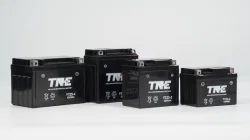How to Charge a Motorcycle Battery
2024-03-29
Charging a motorcycle battery is a straightforward process, but it's essential to follow the correct steps to ensure safety and proper charging. Here's a general guide on how to charge a motorcycle battery:
1. Preparation:
- Park your motorcycle in a well-ventilated area away from flammable materials.
- Turn off the motorcycle's ignition and remove the key.
- Wear appropriate safety gear, including gloves and safety glasses, to protect yourself from acid spills and electrical hazards.
2. Inspect the Battery:
- Inspect the battery for any signs of damage, corrosion, or leaks. If the battery is damaged or leaking, do not attempt to charge it; replace it instead.
- Ensure the battery terminals are clean and free of corrosion. If necessary, clean the terminals with a battery terminal cleaner or a mixture of baking soda and water.
3. Select a Charger:
- Choose a motorcycle battery charger compatible with your battery's voltage and chemistry (e.g., lead-acid, AGM, gel).
- Make sure the charger's output current rating is suitable for your battery's capacity. Avoid using automotive battery chargers, which may deliver too much current for a motorcycle battery.
4. Connect the Charger:
- Identify the positive (+) and negative (-) terminals on the battery. The positive terminal is typically marked with a "+" symbol or colored red, while the negative terminal is marked with a "-" symbol or colored black.
- Connect the positive (+) charger clamp to the positive (+) terminal of the battery.
- Connect the negative (-) charger clamp to the negative (-) terminal of the battery.
- Ensure the charger clamps make secure and tight connections to the battery terminals to prevent arcing or sparking.
5. Set Charging Parameters:
- Set the charger to the appropriate charging mode or voltage setting for your battery type (e.g., lead-acid, AGM, gel).
- If your charger offers multiple charging modes (e.g., trickle charge, maintenance mode), select the mode suitable for your battery's state of charge and condition.
6. Start Charging:
- Plug in the charger to a grounded electrical outlet.
- Turn on the charger and initiate the charging process. The charger should display the charging status (e.g., charging, fully charged).
- Monitor the charging process and check the battery and charger periodically for any signs of overheating, unusual noises, or other abnormalities.
7. Finish Charging:
- Allow the battery to charge fully until the charger indicates that charging is complete.
- Turn off the charger and unplug it from the electrical outlet.
- Disconnect the charger clamps from the battery terminals, starting with the negative (-) clamp followed by the positive (+) clamp.
8. Test the Battery:
- After charging, test the battery voltage with a multimeter to ensure it has reached the appropriate voltage level for a fully charged battery (e.g., around 12.6 volts for a 12-volt battery).
- If necessary, perform a load test or use a battery tester to verify the battery's capacity and health.
Following these steps will help you safely and effectively charge your motorcycle battery, ensuring reliable starting power for your motorcycle. If you encounter any issues during the charging process or if the battery fails to hold a charge, it may be time to replace the battery with a new one.



